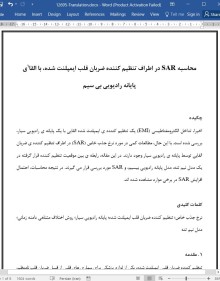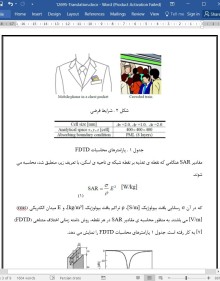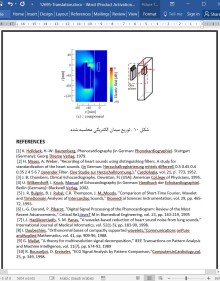
دانلود مقاله محاسبه SAR در اطراف تنظیم کننده ضربان قلب ایمپلنت شده، با القای پایانه رادیویی بی سیم
چکیده
اخیرا، تداخل الکترومغناطیسی (EMI) یک تنظیم کننده ی ایمپلنت شده القایی با یک پایانه ی رادیویی سیار، بررسی شده است. با این حال، مطالعات کمی در مورد نرخ جذب خاص (SAR) در اطراف تنظیم کننده ی ضربان القایی توسط پایانه ی رادیویی سیار وجود دارند. در این مقاله، رابطه ی بین موقعیت تنظیم کننده قرار گرفته در یک مدل نیم تنه، مدل پایانه رادیویی بیسیم، و SAR مورد بررسی قرار می گیرند. در نتیجه محاسبات، احتمال افزایش SAR در برخی موارد مشاهده شده اند.
1 . مقدمه
تنظیم کننده ضربان قلبی ایمپلنت شده، یکی از لوازم پزشکی برای بیماری های قلبی از قبیل ضربان قلب نامنظم، فیبریلاسیون دهلیزی، و ....، می باشد، و در قفسه ی سینه ی بیمار ایمپلنت می شود (شکل 1). اخیرا، تداخل الکترومغناطیسی (EMI) تنظیم کننده ی ایمپلنت شده با یک پایانه ی رادیویی سیار بررسی شده است [1]-[3]. بر اساس این مطالعات، متخصصان ملی ژاپن توصیه کرده اند که پایانه ی رادیویی سیار باید در فاصله 22 cm تنظیم کننده قرار بگیرد [4]. بعلاوه، توزیع SAR در بدن به ویژه در اطراف تنظیم کننده، هنگامی که پایانه ی رادیویی سیار به قفسه ی سینه ی بیمار نزدیکی می شود، باید در نظر گرفته شود (شکل 2). در این مطالعه، توزیع SAR در اطراف مدل تنظیم کننده ضربان کاشته شده در یک مدل نیم تنه مستطیلی متوازی الاضلاع، با توجه به مدل پایانه ی رادیویی سیار، محاسبه شده است.
4 . نتیجه گیری
مطابق نتایج، SAR در اطراف هادی، که درون بدن انسان ایمپلنت شده است، افزایش می یابد. در مقاله ی [8] نتایج این مطالعه تایید شده اند. در واقع، SAR میانگین 10-g در کمتر از 2 W/kg، توسط دستورالعمل قرار گیری انسان در معرض میدان الکترومغناطیسی در ژاپن، محدود شده است. بعلاوه، هنگامی که هادی ها درون بدن انسان کاشت می شوند، راهنما نشان می دهد که احتمال قرارگیری در معرض امواج زیر این خط راهنما باعث گرمایش محلی می شود. بنابراین، مقدار راهنما (2 W/kg) در این حالت به کار نرفته است. با این حال، با افزایش تعداد کاربران تنظیم کننده ی ضربان، این مورد باید در راهنما اعمال شود [9]. بنابراین، اثرات هادی های ایمپلنت شده بر SAR باید به طور کامل بررسی شوند [10].
Abstract
Recently, electromagnetic interference (EMI) of an implanted pacemaker induced by a mobile radio terminal has been investigated. However, there are few studies of specific absorption rate (SAR) around the pacemaker induced by the mobile radio terminal. In this paper, the relation between position of pacemaker model embedded into the torso model, wireless radio terminal model and SAR has been investigated. As a result of calculations, possibilities of increasing the SAR were observed in some cases.
I. INTRODUCTION
The implanted cardiac pacemaker is one of the medical devices for cardiac diseases such as irregular heartbeat, ventricular fibrillation, etc. and is implanted in the chest of patient (Fig. 1). Recently, electromagnetic interference (EMI) of an implanted pacemaker with a mobile radio terminal has been investigated [1]-[3]. Based on these studies, national authorities have recommended that a mobile radio terminal should be kept 22 cm from the pacemaker in Japan [4]. Meanwhile, SAR distribution in the body especially around the pacemaker, when the mobile radio terminal closes to chest of the pacemaker holder, has to be considered (Fig. 2). In this study, the SAR distributions around the pacemaker model embedded into a rectangular parallelepiped torso model due to a mobile radio terminal model were calculated.
IV. CONCLUSIONS
According to the results, the SAR around the conductor, which is implanted in the human body, increased. It is confirmed in [8] as well as our results. In fact, 10-g averaged SAR has been limited in less than 2 W/kg by the guideline on human exposure to electromagnetic fields in Japan. In addition, when the conductors were implanted into the human body, the guideline indicated that the possibility of the exposure below the guideline value might cause a local heating. Thus, the guideline value (i. e. 2 W/kg) was not applied in this case. However, as increasing number of pacemaker user, such a case must be applied to the guideline [9]. Therefore, the influences on SAR by the implanted conductors have to be investigated in detail [10].
چکیده
1 . مقدمه
2 . مدل عددی
3 . نتایج محاسبات
4 . نتیجه گیری
منابع
Abstract
1. INTRODUCTION
2. NUMERICAL MODEL
3. CALCULATED RESULTS
4. CONCLUSIONS
REFERENCES
- اصل مقاله انگلیسی با فرمت ورد (word) با قابلیت ویرایش
- ترجمه فارسی مقاله با فرمت ورد (word) با قابلیت ویرایش، بدون آرم سایت ای ترجمه
- ترجمه فارسی مقاله با فرمت pdf، بدون آرم سایت ای ترجمه



